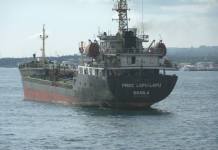The AUKUS trilateral agreement signed between the US, the UK with Australia to arm the latter with nuclear submarines has been marred with controversies. Aimed at creating effective nuclear deterrence against China, AUKUS has now entered its first phase.
US Marines’ F-35B Thwarted Attacks By Chinese-Designated Stealth Fighters In One Of The Biggest War Drills In Indo-Pacific
A Congressional Research Service ‘In Focus’ report on AUKUS Nuclear Cooperation was published on March 11, 2022. It analyzed the onset of the maiden phase of nuclear technology transfer to Australia from the United States under AUKUS, based on previous documents submitted to Congress.
According to the contents of the report, In December 2021, American President Joe Biden had sent an agreement titled- “Agreement among Australia, the United Kingdom, and the United States for the Exchange of Naval Nuclear Propulsion Information” that outlined a new project for exchanging nuclear propulsion technology with Australia.
An accompanying message to Congress explained that the agreement would permit the three governments to “communicate and exchange Naval Nuclear Propulsion Information and would provide authorization to share certain Restricted Data as may be needed during trilateral discussions” concerning a project to develop Australian nuclear-powered submarines.
In November of last year, Australia inked a nuclear submarine technology-sharing deal with the United States and the United Kingdom as part of the AUKUS defense agreement.
Countering Russia’s Powerful Submarine Force, British P-8 Poseidons Conducted 1st Anti-Sub Ops From A Foreign Base
Australian Prime Minister Scot Morrison had lauded the deal and said “The Agreement will provide a mechanism for Australian personnel to access invaluable training and education from our US and UK counterparts, necessary for learning how to safely and effectively build, operate and support nuclear-powered submarines”.

AUKUS – A Historic Pact?
The United Kingdom is the only other country with whom the United States has shared its nuclear propulsion technology, as part of the 1958 Mutual Defense Agreement.
The Agreement between the Governments of the United Kingdom of Great Britain and Northern Ireland and the Government of the United States of America for ‘Cooperation on the Uses of Atomic Energy for Mutual Defense Purposes’ was signed on July 3, 1958, by the then US Secretary of State John Foster Dulles and British Minister Samuel Hood.
Signed in the backdrop of the Cold War and the increasing polarization of the world among the West and the Soviet Union, the agreement represented the close cooperation between the two Western allies. It also allowed the west to consolidate nuclear deterrence against the expanding Communist USSR.
On the completion of 60 years of the agreement, U.K. Ministry of Defense Permanent Secretary Stephen Lovegrove had said, “From promoting peace to fighting terrorism, the special relationship between Britain and the U.S. is one built on shared values and years of cooperation. The U.S. is one of our closest allies and we hope to share another 60 years of defending peace and stability throughout the world during such uncertain times.”
US Prepares To Deliver Its ‘Most-Powerful’ Abrams Main Battle Tanks To Taiwan Amid ‘Chinese Invasion’ Threats
On the other hand, the AUKUS pact was signed last year amid heightened tensions between the West and nuclear-armed China which has been steadily gaining ground in the Pacific.
In fact, the US fears that China’s long-range nuclear-capable missiles like the DF-26 can put its assets in the Pacific in jeopardy. Apart from arming Australia with nuclear subs, it has also decided to strengthen its presence in the country.
This morning I met with UK High Commissioner Victoria Treadell and US Chargé d’Affaires Michael Goldman to sign the AUKUS Exchange of Naval Nuclear Propulsion Information Agreement. This Agreement formalises Australian access to highly sensitive nuclear submarine technology. pic.twitter.com/UtKYRl6PwS
— Peter Dutton (@PeterDutton_MP) November 22, 2021
China has been a vocal opponent of the AUKUS agreement, claiming that it violates the Non-Proliferation Treaty’s principles, poses a threat to regional stability, and contradicts the precedent of a nuclear-free Southeast Asian region.
According to the Lowy Institute’s 2021 Poll, 63 percent of Australians regard China as a security danger, up 22% from the previous year. The rapid worsening of relations with Beijing has only heightened calls for Canberra to do more to strengthen its alliance with the United States. In that respect, AUKUS certainly has China as a goal.
However, despite the controversies, the AUKUS arrangement indeed has been a historical move and a stern departure from the American policy against sharing nuclear technology.

Will Australia Build Nuclear Subs In Record Time?
The AUKUS plan begins with an eighteen-month study period aimed “to seek an optimal pathway to deliver” nuclear propulsion technology to Australia. The research is said to be in its early phases, with the specifics still being ironed out.
The agreement, which the governments signed on November 22, 2021, permits each party to exchange “naval nuclear propulsion information as is determined to be necessary to research, develop, design, manufacture, operate, regulate, and dispose of military reactors.” As noted, this information includes restricted data; the AEA defines such data to include “all data concerning … the use of special nuclear material in the production of energy.”

However, Australia has no nuclear weapons and does not use electricity generated by radioactive materials. While it does include a single nuclear reactor, it is used only for non-military research. Australia, on the other hand, is a major uranium exporter.
Australia does not have any nuclear power plants at the moment, although it does have one research reactor. This agreement “specifically prohibits the transfer of restricted data,” as well as “sensitive nuclear technology, sensitive nuclear facilities, and major critical components.”
A major issue concerning Australia’s construction of a nuclear submarine is the lack of nuclear infrastructure, to begin with. The submarines will be built in Australia, but not the reactor compartments because the country’s current plans do not include establishing a nuclear-power industry capable of sustaining the program, according to Australian PM Scott Morrison.
As a result, one of the most important requirements for Australia would be a reactor design that will not require refueling during the submarines’ estimated service lifespan of up to 35 years, writes Nick Child, Senior Fellow for Naval and Maritime Security at IISS.
He also argues that a large amount of expert shipbuilding investment, as well as supporting infrastructure, will be necessary to assure the submarines’ and their propulsion systems’ safe and effective operation. This will necessitate the use of UK and US expertise, which means diverting engineers and resources.
It could be, thus, pertinent to wonder whether the transfer of nuclear technology from the US and the UK to Australia would be as holistic and smooth as the Mutual Defense Agreement concluded between the two western stalwarts, decades ago.
Even with strong support from the US and the UK, Australia will need years to build cutting-edge nuclear-powered submarines. It has been recommended that Australian submarine sailors train on older American or British submarines that are about to be retired as a workaround.
Another alternative could be to provide nuclear submarines to Australia, either American or British, as a stopgap measure until Canberra can operate its own nuclear submarines. Some experts have speculated that Australia could have a nuclear submarine only by 2030, however, leasing one from the US is always an option.
It could be years before Australia builds its own nuclear submarine from scratch using the technology acquired from the US and UK but the first phase of the agreement could be one step in that direction.
- Contact the author at sakshi.tiwari9555@gmail.com
- Follow EurAsian Times on Google News





